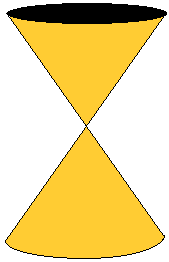Critique of conic sections

Although we've been consistent here with the Classical Greek notion of cone, a modern concept of cone differs in three ways: 1) It might be generated by lines moving around an ellipse instead of a circle. 2) It consists of two pieces, each of which is like the cones we've been considering. Each piece is called a nappe (pronounced "nap"). 3) Each piece extends indefinitely. Technically, what we've been thinking of is a truncated nappe of a circular cone.
An ellipse is the intersection of a nappe of a circular cone with a plane that cuts all of the generators of the cone. To make a parabola, the plane must tilt enough to be parallel to one generator. But if it tilts even more, to make a hyperbola, won't it again cut all of the cone's generators? It's just that for a hyperbola it cuts some of the generators in one nappe of the cone and some in the other.
We can also ask some extension questions:
What if not circular? What if we begin with an elliptical cone that is not necessarily circular? Are all sections ellipses? Is one of the sections necessarily a circle?
Can we generalize properties of circles to ellipses? For example, in a
circle, all points are equidistant from the center, and tangent lines are
perpendicular to radii to the same point. Are there analogous properties
for the ellipse?











